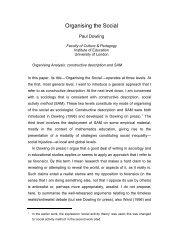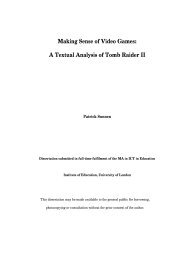Research and the Theoretical Field - Pauldowling.me
Research and the Theoretical Field - Pauldowling.me
Research and the Theoretical Field - Pauldowling.me
You also want an ePaper? Increase the reach of your titles
YUMPU automatically turns print PDFs into web optimized ePapers that Google loves.
46<br />
The expression, ‘research question’ might not be entirely appropriate in <strong>the</strong><br />
context of this kind of ethnography. This mode of research sets out to<br />
establish an underst<strong>and</strong>ing of <strong>the</strong> way that <strong>the</strong> culture works <strong>and</strong> of <strong>the</strong><br />
<strong>me</strong>anings of ‘shaped behaviours’. So it may be better to refer to this as <strong>the</strong><br />
research problem. One would expect it to be stated in very general terms at<br />
<strong>the</strong> outset. By <strong>the</strong> ti<strong>me</strong> that <strong>the</strong> work has been completed, <strong>the</strong> ethnographer<br />
will have established <strong>the</strong>ir reading of <strong>the</strong> culture, given it a particular character<br />
that marks out its singularity (<strong>and</strong> so also its continuities with o<strong>the</strong>r cultures) in<br />
terms of how its <strong>me</strong>mbers think about <strong>the</strong>ir world. Geertz’s reading will be<br />
presented as thick description <strong>and</strong>, to <strong>the</strong> extent that this captures <strong>the</strong><br />
character of <strong>the</strong> culture, this may be regarded as <strong>the</strong> conclusion to <strong>the</strong><br />
research.<br />
Incorporation<br />
Weak<br />
Strong<br />
Structure<br />
Complex Backwater isolation Conservative hierarchy<br />
Weak Active individualism Dissident enclave<br />
Table 4.1<br />
Mary Douglas’s ‘Cultural Theory’ (modified from Douglas, 1996; p. 43) 3<br />
So<strong>me</strong> approaches to anthropology make use of more structured <strong>the</strong>ory. Mary<br />
Douglas, for example, claims that <strong>the</strong>re are ‘four distinct kinds of culture, no<br />
one of which can flourish in <strong>the</strong> conditions predicated for any of <strong>the</strong> o<strong>the</strong>rs.’<br />
(Douglas, 1996; p. 142). Her four kinds of culture are differentiated on <strong>the</strong><br />
basis of two binary variables as in Figure 4.1. Douglas refers to this as<br />
‘cultural <strong>the</strong>ory’. Consistent with this approach, we might constitute a research<br />
question that seeks to verify (or refute or transform) <strong>the</strong> <strong>the</strong>ory, thus: under<br />
what conditions can different cultural forms co-exist; how do cultures change<br />
between forms; can we find a society that excludes one or more cultural form<br />
The point, here, is that it is <strong>the</strong> <strong>the</strong>oretical space that is opened up by<br />
<strong>the</strong> most likely distribution of any given variable in <strong>the</strong> sample is <strong>the</strong> sa<strong>me</strong> as its distribution in<br />
<strong>the</strong> sampling fra<strong>me</strong>. So, if <strong>the</strong> sampling fra<strong>me</strong> consists of equal numbers of males <strong>and</strong><br />
females, <strong>the</strong>n <strong>the</strong> most likely outco<strong>me</strong> from taking a r<strong>and</strong>om sample is that <strong>the</strong> sample will<br />
also have an equal distribution of males <strong>and</strong> females. Perhaps a better way of putting this is<br />
that <strong>the</strong>re is an increasingly small probability of a r<strong>and</strong>om sample differing substantially from<br />
<strong>the</strong> sampling fra<strong>me</strong>. What this <strong>me</strong>ans is that, for example, you can take two r<strong>and</strong>om samples<br />
<strong>and</strong> make <strong>the</strong> assumption that, for most purposes, <strong>the</strong> properties of <strong>the</strong> samples can be<br />
considered to be <strong>the</strong> sa<strong>me</strong>. However, careful consideration has to be given to <strong>the</strong> size of <strong>the</strong><br />
sample—just <strong>the</strong> size, its size relative to <strong>the</strong> sampling fra<strong>me</strong> is not relevant.<br />
3 I have modified Douglas’s table to conform to my own preferred style of representing crossproducts<br />
of two binary variables. There is an important difference, however, between<br />
Douglas’s structure <strong>and</strong> <strong>the</strong> kinds of analytic apparatuses that I generate (see, for example,<br />
Dowling, 2005a, 2005b, in press; Dowling & Brown, 2006). Essentially, Douglas’s modernism<br />
fixes cultures within one or o<strong>the</strong>r of <strong>the</strong> four cells. My, more postmodern or amodern (Latour,<br />
1993) approach presents a 2x2 space as a map for exploring <strong>the</strong> dynamics of a setting.<br />
RESEARCH & THE THEORETICAL FIELD




